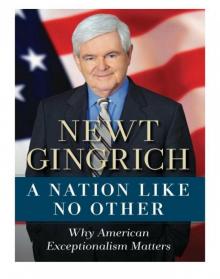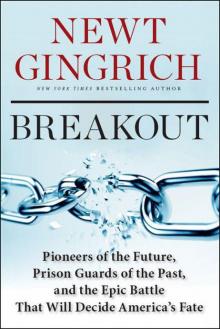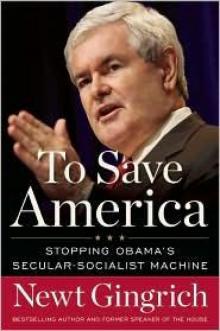- Home
- Newt Gingrich
Understanding Trump Page 9
Understanding Trump Read online
Page 9
As the veteran journalist and Weekly Standard editor Fred Barnes wrote in January 2013:
My drift here ought to be obvious. I’m referring to the way the media treat Obama. It’s not always adoring. It’s intermittently fair and even-handed. But overall, what’s distinctive about the press coverage of Obama is the absence of fault-finding, criticism, and dogged questioning. And when Obama makes excuses, as he often does, the media tend to echo them.
No president in my lifetime has been covered so favorably and so gingerly. Never has the press corps been so unwilling to pursue stories that might cast the president in an unflattering light. As a group, the media pride themselves on taking an adversarial approach to politicians and government officials. But in Obama’s case, the press acts like a helpmate.2
Barnes further points out that Obama’s treatment by the press is even more pronounced when compared with coverage of George W. Bush. Barnes notes that Bush was constantly criticized for tactics he used while fighting terrorism, the use of Guantanamo Bay detention facility, and his use of surveillance provisions under the Patriot Act. Meanwhile, when Obama used similar tactics, failed to close Guantanamo as he promised, and specifically when he signed legislation to continue warrantless wiretapping in the United States for intelligence gathering, “Bush was harshly criticized by the media on this very issue. Obama got a pass,” Barnes wrote.
It wasn’t until the end of Obama’s eight years in office that the press started to realize he was not the champion they had hoped for. Once the media awoke from a nearly decade-long Obama groupthink, journalists were almost surprised to realize he had been one of the most secretive, opaque politicians to sit in the Oval Office. After Obama’s lecturing journalists in a March 2016 speech, and tweaking reporters for giving what he called “false equivalence” to coverage of Donald Trump’s candidacy, Politico Magazine writer Jack Shafer had enough. He wrote on March 29, 2016:
How do we hate Obama’s treatment of the press? Let me count the ways. Under his administration, the U.S. government has set a new record for withholding Freedom of Information Act requests, according to a recent Associated Press investigation. FOIA gives the public and press an irreplaceable view into the workings of the executive branch. Without timely release of government documents and data, vital questions can’t be answered and stories can’t be written.
Shafer went on to express frustration over Obama’s “insider threat program” which was a concentrated effort to find and punish government whistleblowers in the administration. Indeed, CNN’s Jake Tapper reported that “the Obama administration has used the Espionage Act to go after whistleblowers who leaked to journalists… more than all previous administrations combined.” The online fact-checking publication PolitiFact rated Tapper’s assessment as true.3
And the New York Times reporter James Risen—whom the Obama administration threatened to jail for refusing to reveal his sources in a leak investigation—called the Obama White House on CNN “the most antipress administration since the Nixon administration” and described it as having tried to “criminalize investigative reporting.”
But the frustrations of Schafer, Tapper, and Risen didn’t seem to catch on with the rest of their media colleagues under Obama. And at the same time, news organizations’ contentment with Obama’s barriers to media access didn’t transfer when they started covering Donald Trump.
When Trump denied access to the Washington Post, the Des Moines Register, and several other publications during the campaign—and later when Press Secretary Sean Spicer didn’t invite several mainstream media outlets to a small, off-camera press meeting in February—news agencies went nuts. The Associated Press even boycotted the Spicer gaggle—deciding that the status of its fellow elite media outlets was more important than informing the public. Meanwhile, in 2008, when Obama kicked the Dallas Morning News, the New York Post and the Washington Times off his campaign plane, the media once again gave him a pass and accepted his assertion that there were no more seats. Glamour kept its spot on the aircraft.
THE MEDIA VERSUS TRUMP
Not only is the press calling foul on Trump when it let Obama skate for similar actions, reporters are actively skewing their coverage of Trump.
As the website RedState reported on February 28, 2017, the New York Times deliberately mischaracterized a speech that President Trump gave at the Conservative Political Action Conference.
During the speech, Trump said, “We are also going to save countless American lives. As we speak today, immigration officers are finding the gang members, the drug dealers, and the criminal aliens and throwing them the hell out of our country.”
In the story by Glenn Thrush, the quote was presented as: “His speech also included a promise to throw undocumented immigrants ‘the hell out of the country’ [italics mine] and a recitation of his law-and-order campaign promises.”
And the media has vociferously pushed false narratives about Donald Trump throughout his candidacy. The New York Times printed a supposed exposé on Trump in May 2016 alleging that he treated former girlfriends poorly.4 The Monday after the weekend article ran, Rowanne Brewer Lane—the paper’s lead source for the story—appeared on Fox & Friends and spoke to several other media outlets because she felt she needed to tell the American people that the New York Times had misrepresented her story.
Brewer Lane said to Fox & Friends that Trump “never made me feel like I was being demeaned in any way. He never offended me in any way. He was very gracious. I saw him around all types of people, all types of women. He was very kind, thoughtful, generous, you know. He was a gentleman.”
It was clear to Brewer Lane that the Times reporters had set out with their own narrative—which is that Trump is some sort of abusive monster—and had planned to malign her comments from the start. Not only did they seek to lie to their readers, but they were brazenly dishonest with Brewer Lane.
“They promised several times that they would do it accurately. They told me several times and my manager several times that it would not be a hit piece and that my story would come across the way that I was telling it and honestly, and it absolutely was not,” she told Fox & Friends.5
This was the moment when I realized something profound was breaking in the old order, and the old order in its desperation was getting clumsy and stupid.
Just consider the Time writer, who was serving as a pool reporter in the White House the day Trump took office. Now, to explain, there are times when it’s unreasonable or impossible to let reporters from all the media outlets cover an event. Most of the time that’s because the space is too small or there are issues with security—as with the Oval Office. So, at times when everyone can’t have a reporter at an event, there are pool reporters whose job it is to represent all the media.
The day Trump was inaugurated, after noting that a bust of Winston Churchill had been moved into the Oval Office, Time magazine writer Zeke Miller told his colleagues in the pool that a bust of Martin Luther King Jr. had been removed. This report of course caused furor throughout the country, as reporters across the nation picked up this juicy tidbit from Trump’s first day. It was a serious charge because it reinforced the Left’s assertion that Trump and Republicans were racist. If true, it would drive a real wedge between African Americans and the new President. There was only one problem: The bust of King was never removed from the Oval Office. It’s still there today. The report was entirely false.
The reporter later claimed in a tweet that the erroneous story was an honest mistake. He said he looked twice for the bust, but it had been obscured by a door or a Secret Service agent. OK, sure. Reporters are people, and people make mistakes. But the trouble with that excuse is it doesn’t explain why the reporter didn’t ask White House Press Secretary Sean Spicer about the bust, or even take a few extra moments to get a better look around the room.
Instead, the reporter saw what he thought was an opportunity to show President Trump in a bad light, and he took it without giving a thought to a
ccuracy or fairness. Counselor to the president Kellyanne Conway later said the lie had been repeated by more than three thousand media outlets.
This situation tipped the media’s hand and laid bare the false narrative they were trying to promote, that Trump brought in the bust of Churchill and had gotten rid of the bust of King, proving how much of a white, imperialistic, racist, “alt-right” president that Trump was going to be. Keep in mind, all this reporting happened immediately after Trump had given an inaugural speech that was completely antidiscriminatory and reaffirmed Trump’s position that to be racist is to be unpatriotic and un-American. Here’s one of the most powerful passages from Trump’s inaugural that illustrates this message:
It is time to remember that old wisdom our soldiers will never forget: that whether we are black or brown or white, we all bleed the same red blood of patriots, we all enjoy the same glorious freedoms, and we all salute the same great American flag.
And whether a child is born in the urban sprawl of Detroit or the windswept plains of Nebraska, they look up at the same night sky, they fill their heart with the same dreams, and they are infused with the breath of life by the same almighty Creator.
So to all Americans, in every city near and far, small and large, from mountain to mountain, and from ocean to ocean, hear these words: You will never be ignored again.
But these words—which came out of the president’s mouth in front of the entire nation—did not fit the media’s narrative of who this president is, so they ignored them.
And the intentional ignorance didn’t stop. In February, a White House correspondent for the American Urban Radio Networks claimed that while on the campaign trail, Trump said that white people built America.
He never said this, or anything like it.
After a day of confusion among White House officials, and rabid excitement from the media, the reporter told the Washington Examiner she was talking about a speech Trump gave on March 12, 2016 in Vandalia, Ohio. Trump was speaking to the entire crowd of people there at the rally, and said:
We cannot let our First Amendment rights be taken away from us, folks. We can’t let it happen. We can’t let it happen. We have a right to speak. I mean, we are law-abiding people. We are people that work very hard. We are people that have built this country and made this country great.
Trump was talking to his supporters after he had to cancel an event in Chicago due to lawless actions by left-wing fascist protestors.
Only a reporter who had a predetermined narrative could construe this statement as being exclusive to white people.
Another perfect example of the media tossing traditional standards aside in order to attack Trump is when BuzzFeed, CNN, and several other news organizations reported on a completely unverified, unsubstantiated report allegedly made by a former British intelligence officer that claimed President Trump and several of his associates were vulnerable to kompromat—which is the Russian term for compromising material used to blackmail, extort, or otherwise influence public officials. The report had been floating around Washington for months, and no official agency had confirmed any of it.
Despite having no way to verify the information, and ignoring the fact that the source of the report had been hired by Hillary Clinton to do opposition research on Trump, the media ran with the story—bypassing even the most basic principles of journalism. Supposedly smart, trained journalists just threw spaghetti on the wall to see if it would stick. To the media, the allegations about Trump must have just been too good to fact-check. In their voracious pursuit of damning news about the president, the media reported that Trump’s lawyer, Michael Cohen, had met with Russians in Prague—which was somehow proof that Trump had a nefarious relationship with the Russian government.
There was one problem: at no point did anyone involved, in either the intelligence community or the press, stop to ask Cohen about the allegation—or consider that there could be more than one person in the world named Michael Cohen. As it turned out, the Cohen who works for Trump had never been to the Czech Republic, much less Prague. Still, the press saw the shot and took it.
This kind of propaganda is what Trump is going to have to face every day of his presidency. And it will be endlessly frustrating to not only Trump—but also for the same Americans who have had their faith in the media eroded.
THE PEOPLE VERSUS THE MEDIA
I was told a story several years ago by Mark Bowden, who wrote Black Hawk Down, that really helps explain the Washington media.
Mark used to work for the Philadelphia Inquirer, and at one point he decided to write a book, Bringing the Heat, about the Philadelphia Eagles football team. The Eagles knew his work and knew that he was a genuinely curious person who wanted to learn about what it was like to be on a team trying to win a championship. Mark told me most of the players were nice to him, but he learned very quickly they despised sports journalists. For the players, the idea of some fifty-year-old overweight guy who couldn’t run twenty yards without passing out, sitting up in the air-conditioned press box bloviating over whether they should have run their touchdown route better just infuriated them.
In fact, you see the same thing in the Washington press and political academia. These people are voyeurs. They don’t do anything.
In the White House press corps, you might have somebody representing the New York Times or Time magazine, who has covered the White House for maybe five years and is therefore empowered to render judgment on the president. The first thing to realize is: This person couldn’t be the president if his or her life depended on it. This person has no clue about how difficult and complex it is to be the president. Yet the media refuse to reassess, continue to be wrong, and will apparently stop at nothing to force their narrative.
And Americans are starting to get sick of it.
According to a Gallup poll published September 14, 2016, public trust in the media has dropped to the lowest level Gallup has ever recorded.
Every year since 1997, the pollster has asked Americans, “In general, how much trust and confidence do you have in the mass media—such as newspapers, TV, and radio—when it comes to reporting the news fully, accurately and fairly?” The available answers are “a great deal,” “a fair amount,” “not very much,” or “none at all.”
In 1997, 55 percent of those polled responded either “a fair amount” or “a great deal.” In 2016, that figure was 32 percent—a 23 point drop over nineteen years. And Gallup’s polling data shows this year was not aberrant, it was right on trend. Trust in media remained between 50 percent and 55 percent from 1997 to 2005, with the exception of a 10-point dip in 2004 that rebounded the following year. But since 2005, through the last part of George W. Bush’s second term and the entirety of President Barack Obama’s two terms in office, trust in media has steadily waned.
I suggest that this might be a good marker for when the media’s left-wing tendencies began to define its coverage on a regular basis. Gallup’s data shows 2005 marked an extreme high for the Left’s trust in the media. While only 31 percent of Republicans and 49 percent of independents found the media trustworthy in 2005, a whopping 70 percent of Democrats thought the nation’s news outlets were doing a good job—likely because at the time they were relentlessly criticizing President Bush. In fact, it has largely been the opinions of independents and Republicans that have driven down the results of Gallup’s media-trust poll.
Over the eight years of Obama’s term, the Left’s approval of the media ranged from 60 percent in 2008 to 55 percent in 2015—only recently dropping to 51 percent in 2016 with Trump’s election. At the same time, distrust of media grew for the rest of the nation. Independents ranged from 41 percent in 2008 to 30 percent in 2016 while Republicans went from 27 percent to 14 percent over the same period.
I expect this trend will continue until the so-called journalists stop being propagandists, rediscover objectivity, and reearn the respect of the American people.
So far, it doesn’t appear that any of
them have learned anything. These are the same people at the New York Times, the Washington Post, CNN, MSNBC, and the rest who failed to understand that Trump would win the Republican primary, were flabbergasted when he won the general election, and have still not stopped to look inward and assess the level to which they were out of touch with most Americans.
Here are a few quick reminders.
Shortly after Trump entered the race, the famed political analyst Nate Silver dismissed him as “the world’s greatest troll.”
“In the long run—as our experience with past trolls shows—Trump’s support will probably fade. Or at least, given his high unfavorable ratings, it will plateau, and other candidates will surpass him as the rest of the field consolidates,” Silver wrote on July 20, 2015.
After Trump beat sixteen other highly qualified candidates in the Republican primary, the Washington Post’s senior political reporter Aaron Blake explained on August 9, 2016, that Trump won by simply going further right than his primary opponents were willing to go, and Trump didn’t understand the nuances of general election campaigning.
“Trump was focused like a laser on the win, and he wasn’t politically experienced or humble enough to grasp that how you claim that win can be just as important come summer and fall,” Blake wrote, later writing that Trump “lost the general election to win the primary. And he clearly still doesn’t understand that.”
And even after Trump became our nation’s 45th president, those in the elite media couldn’t reconcile that the narrative they had painstakingly built over the election didn’t stick with the American people. In response, they immediately focused their effort trying to reenforce that narrative and explain the mistake the voters had clearly made.

 1945
1945 Collusion
Collusion Trump's America
Trump's America Shakedown
Shakedown A Nation Like No Other
A Nation Like No Other To Try Men's Souls - George Washington 1
To Try Men's Souls - George Washington 1 Pearl Harbor: A Novel of December 8th
Pearl Harbor: A Novel of December 8th Valley Forge: George Washington and the Crucible of Victory
Valley Forge: George Washington and the Crucible of Victory To Save America
To Save America Grant Comes East cw-2
Grant Comes East cw-2 Victory at Yorktown: A Novel
Victory at Yorktown: A Novel Days of Infamy
Days of Infamy The Battle of the Crater: A Novel (George Washington Series)
The Battle of the Crater: A Novel (George Washington Series) Breakout: Pioneers of the Future, Prison Guards of the Past, and the Epic Battle That Will Decide America's Fate
Breakout: Pioneers of the Future, Prison Guards of the Past, and the Epic Battle That Will Decide America's Fate Pearl Harbour and Days of Infamy
Pearl Harbour and Days of Infamy Pearl Harbour - A novel of December 8th
Pearl Harbour - A novel of December 8th Understanding Trump
Understanding Trump To Save America: Abolishing Obama's Socialist State and Restoring Our Unique American Way
To Save America: Abolishing Obama's Socialist State and Restoring Our Unique American Way